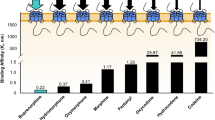Abstract
The antagonist effects of clocinnamox were evaluated against opioid agonists, acting at μ, κ and ∂-receptors, in rhesus monkeys (n=3–4) responding under a fixed-ratio 30 (FR 30) schedule for food delivery. Clocinnamox (0.032–0.1 mg/kg) dose-dependently antagonized fentanyl (0.001–0.32 mg/kg) after either a 3-h or 1-day pretreatment; there was substantial recovery of agonist potency by 1 week after clocinnamox. Etonitazene (0.0001–0.01 mg/kg) was also antagonized by clocinnamox (0.1 mg/kg), but to a lesser extent than fentanyl. The smaller extent of antagonism was not due to the appearance of non μ-opioid response-decreasing effects of etonitazene, since the competitive antagonist quadazocine (0.1 mg/kg) shifted the etonitazene dose-effect curve in the presence of clocinnamox (0.1 mg/kg). Clocinnamox (0.1–0.32 mg/kg) did not antagonize the rate-suppressing effects of the ∂-agonist BW373U86 (0.0.01-1.0 mg/kg) or the κ-agonist U69,593 (0.001–0.032 mg/kg). These results are consistent with previous in vivo and in vitro evidence that characterized clocinnamox as an insurmountable antagonist, with selectivity for μ-over κ- and δ-receptors.
Similar content being viewed by others
References
Adams JU, Paronis CA, Holtzman SG (1990) Assessment of relative intrinsic activity of mu-opioid analgesics in vivo by using beta-funaltrexamine. J Pharmacol Exp Ther 255:1027–1032
Burke T, Woods JH, Lewis JW, Medzihradsky F (1994) Irreversible opioid anatagonist effects of clocinnamox on opioid analgesia and mu receptor binding in mice. J Pharmacol Exp Ther 271:715–721
Butelman ER, France CP, Woods JH (1995a) Agonist and antagonist effects of dynorphin A-(1–13) in a thermal antinociception assay in rhesus monkeys. J Pharmacol Exp Ther 275:374–380
Butelman ER, Negus SS, Gatch MB, Chang KJ, Woods JH (1995b) BW373U86, a ∂-opioid receptor agonist, reverses bradykinin-induced thermal allodynia in rhesus monkeys. Eur J Pharmacol 277:285–287
Comer SD, Burke TF, Lewis JW, Woods JH (1992) Clocinnamox: a novel, systematically-active irreversible opioid antagonist. J Pharmacol Exp Ther 262:1051–1056
France CP, Medzihradsky F, Woods JH (1994) Comparison of κ opioids in rhesus monkeys: behavioral effects and receptor binding affinities. J Pharmacol Exp Ther 268:47–58
Mjanger E, Yaksh T (1991) Characteristics of dose-dependent antagonism by beta-funaltrexamine of the antinociceptive effects of intrathecal mu agonists. J Pharmacol Exp Ther 258:544–550
Negus SS, Burke TF, Medzihadsky F, Woods JH (1993) Effects of opioid agonists selective for mu, kappa and delta opioid receptors on schedule-controlled responding in rhesus monkeys: antagonism by quadazocine. J Pharmacol Exp Ther 267:896–903
Negus SS, Butelman ER, Chang KJ, DeCosta BR, Winger G, Woods JH (1994) Behavioral effects of the systemically active delta opioid agonist BW373U86 in rhesus monkeys. J Pharmacol Exp Ther 270:1025–1034
Pasternak GW (1993) Pharmacological mechanisms of opioid analgesics. Clin Neuropharmacol 16:1–18
Walker EA, Butelman ER, DeCosta BR, Woods JH (1993) Opioid thermal antinociception in rhesus monkeys: receptor mechanisms and temperature dependency. J Pharmacol Exp Ther 267:280–286
Walker EA, Zernig G, Woods JH (1995) Buprenorphine antagonism of mu opioids in the rhesus monkey tail withdrawal procedure. J Pharmacol Exp Ther 273:1345–1352
Zernig G, Butelman ER, Lewis J, Woods JH (1994) In vivo determination of mu opioid receptor turnover in rhesus monkeys after irreversible blockade with clocinnamox. J Pharmacol Exp Ther 269:57–65
Zernig G, Burke T, Lewis JW, Woods JH (1995) Clocinnamox blocks only mu receptors irreversibly: binding evidence. Regul Pept (in press)
Zimmerman D, Leander DJ, Reel J, Hynes MD (1987) Use of beta-funaltrexamine to determine mu opioid receptor involvement in the analgesic activity of various opioid ligands. J Pharmacol Exp Ther 241:374–378
Author information
Authors and Affiliations
Additional information
Animals used in these studies were maintained in accordance with the University Committees on the Use and Care of Animals, University of Michigan, and Guidelines of the Committee on the Care and Use of Laboratory Animals of the Institute of Laboratory Animal Resources, National Health Council (Department of Health, Education and Welfare, Publication No. (NIH) 85-23, revised 1983). Support for this research was provided by USPHS grant DA 00254.
Rights and permissions
About this article
Cite this article
Butelman, E.R., Negus, S.S., Woods, J.H. et al. Clocinnamox antagonism of opioid suppression of schedule-controlled responding in rhesus monkeys. Psychopharmacology 123, 320–324 (1996). https://doi.org/10.1007/BF02246641
Received:
Revised:
Issue Date:
DOI: https://doi.org/10.1007/BF02246641




